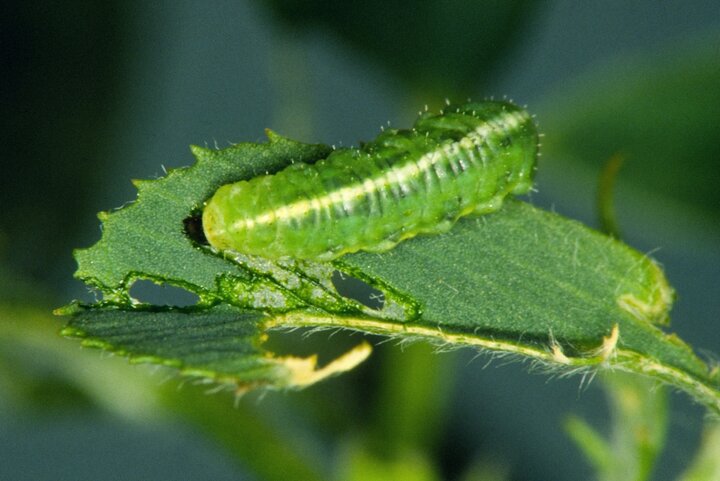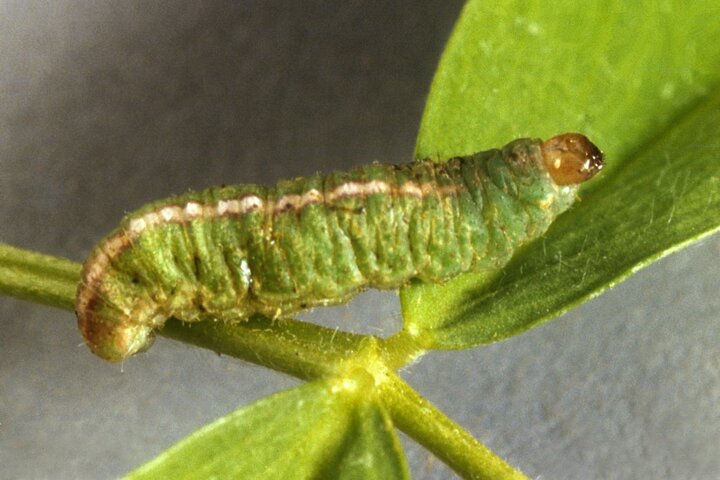Alfalfa weevil larvae have been reported from north central Kansas for a while and we are now seeing them in Nebraska. As temperatures warm up, expect to see alfalfa weevil larvae in southern Nebraska and slightly later, in northern Nebraska.
Both the alfalfa and clover leaf weevils feed on first cutting alfalfa as larvae, and regrowth after the first cutting as adults (and sometimes larvae). While research in northeast Nebraska has shown that clover leaf weevil larva feeding does not cause yield reduction to first cutting alfalfa, alfalfa weevil feeding can cause severe losses to yield and quality of the first cutting. This is why it's important to correctly identify the type of weevil feeding causing damage.
The following chart highlights some of the key identifiers used to distinguish these two weevils.

Alfalfa Weevil
- Overwinter primarily as adults
- Adults are brown with a dark brown stripe halfway down the back, and 3/16 inch long
- Larvae prefer to feed on tips
- Larvae remain on the plant most of the time.
- Larvae have black heads
- Adults leave fields in June

(Photo courtesy Oregon State University Extension)
Clover Leaf Weevil- Overwinter primarily as larvae
- Adults are dark brown, pitted light brown underneath, and over 1/4 inch long
- Larvae feed anywhere on plant
- Most larvae are in soil or debris during daytime hours
- Larvae have brown heads
- Adults may remain in fields
Clover Leaf Weevils
Clover leaf weevils are occasionally a problem, but are vulnerable to fungus disease. These pests haven't been a problem since the late 80s to early 90s when spring rains were rare. Dry conditions over the past several years in western Nebraska may have helped populations increase, although recent rains may have knocked down populations.
Scouting. To scout for clover leaf weevil, look in the debris around the crowns during day. Scratching in the soil around the crowns and counting the number of larvae found per crown will help give a better idea of clover leaf weevil infestation. Their brown heads will help distinguish them from the black-headed alfalfa weevil. (See comparison chart for more information distinguishing the clover leaf weevil and alfalfa weevil.)
Alfalfa Weevils
Life Cycle. Most alfalfa weevils overwinter as adults, become active as temperatures increase, and lay eggs which hatch out as larvae and begin feeding in alfalfa. Some weevils may lay eggs in the stem during fall and, if winter is not too severe, will successfully overwinter. These eggs will hatch earlier than those laid in spring. This is most likely to occur in southern counties.
In some areas of Nebraska, alfalfa weevils do not follow this seasonal pattern. In the Panhandle and in the northern tier of counties there may be two flushes of weevil larvae in the spring. In the last few years some areas of the state have received damage to regrowth after the first cutting due to a combination of late larval feeding and adult feeding. This is something to be aware of after the first cutting.
While alfalfa weevil damage has been spotty in much of Nebraska over the past few years, the potential for damage always exists. Even with the pressure of planting row crops, producers growing high quality alfalfa hay should make time to monitor fields for weevils over the next few weeks.
Scouting. It is essential that fields be monitored for alfalfa weevil feeding now. Damage consists of small holes and interveinal feeding on the newest leaflets near the stem tips. The larvae are small (1/16 to 3/8 inch long) and pale yellowish green, becoming a darker green when larger. These legless worms have black heads and a white stripe the length of the back. The alfalfa weevil larvae spend nearly all their time on the plant. They curl into a C-shape when disturbed.
Once the alfalfa is high enough to use a sweep net, take a sample to establish whether weevils are present. If they are, randomly select at least five sampling sites from across the entire field. At each site, gently pick or cut at least 10 alfalfa stems at ground level. Shake the larvae off the stems by beating the stems into a deep-sided bucket. Count the larvae and determine the average number of larvae per stem. Make sure to check for small larvae that may be enclosed in new, folded leaflets at the tips of the stems. Measure stem lengths and determine the average stem height. Use these averages in Table 1 to determine the appropriate action.
Alfalfa Weevil Economic Thresholds
Economic thresholds have been developed to aid decision making on alfalfa weevil control. We present thresholds and recommendations for 50% bud and later in Table 1. These thresholds were derived by North Dakota State University entomologists (Beauzay et al. 2013; http://www.ag.ndsu.edu/pubs/plantsci/pests/e1676.pdf ) from a two-year study conducted at the UNL Agricultural Research and Development Center near Mead in 1990 and 1991 (Peterson et al. 1993). These guidelines can fluctuate depending on growing conditions and variety.
Deciding whether to treat or re-sample depends on the average number of weevils per stem, the stem length, treatment costs, and the value of the alfalfa. When alfalfa reaches 50% or more bud stage, it may be more profitable to cut the alfalfa early than treat it.
Insecticides
Because alfalfa weevil natural enemies have the potential to keep weevils from reaching economic injury levels, use insecticides only when necessary.
Many insecticides are registered to control alfalfa weevil larvae. See the most recent edition of the Guide for Weed Management in Nebraska with Insecticide and Fungicide Information (UNL EC130) for rates and restrictions of commonly used insecticides for alfalfa weevil larval control. They differ in their modes of action and pre-harvest intervals. Highly effective insecticides for alfalfa weevil control include those that are pyrethroids (active ingredient ends in "thrin").
Pyrethroid insecticides also can have detrimental effects on any beneficial insects present.
Resources
- Integrated Pest Management of Alfalfa Weevil in North Dakota (E1676), by Patrick B. Beauzay, Janet J. Knodel, G.A.S.M. Ganehiarachchi, 2013. NSDU Extension Service, Fargo, ND.
- Yield Responses of Alfalfa to Simulated Alfalfa Weevil Injury and Development of Economic Injury Levels by R.K.D. Peterson, S.D. Danielson and L.G. Higley, 1993. Agronomy Journal 85: 595-601; view abstract.
